

AN INTRODUCTION TO THE MAMMALS OF
BRITISH COLUMBIA
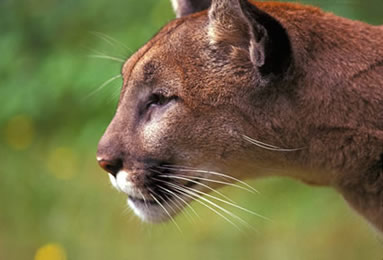
Cougar (Puma concolor). Photo by David Shackleton.
by
Dave Nagorsen
Research Associate, Cowan Vertebrate Museum--
Beaty Biodiversity Museum, UBC
September 30, 2009
View the Checklist of the Mammals of British Columbia
Visit the mammal atlas pages
Who Are the Mammals
The vertebrate Class Mammalia includes 5,416 living species of mammals. They are grouped into 28 Orders consisting of three major phylogenetic groups: monotremes, marsupials, and placental mammals. The most specious Orders are the rodents (Rodentia) and bats (Chiroptera) and together they account for more than 60% of the world’s mammalian species. Defining traits that distinguish mammals from other vertebrates include: hair, three inner ear bones, a lower jaw that consist of single dentary bone that articulates with the squamosal bone of the skull, teeth that vary in form and function, red blood cells that lack nuclei, mammary glands that produce milk, a muscular diaphragm, and an enlarged brain with an enlarged cranium.
An extraordinary feature of mammals is their size range. Contenders for the world’s smallest mammals are the Hog-nosed Bat of Thailand and the Etruscan Shrew of Eurasia that weigh in at ~ 2 grams and have body lengths ~30 mm. At the other extreme reaching 30 m in length and 136, 000 kg is the Blue Whale, the largest animal that ever lived. The mammals have undergone a spectacular range of adaptive radiations particularly in their diets and locomotion. These adaptations are reflected in striking morphological differences in the skulls, jaws, teeth, body form, and appendages of the various groups.
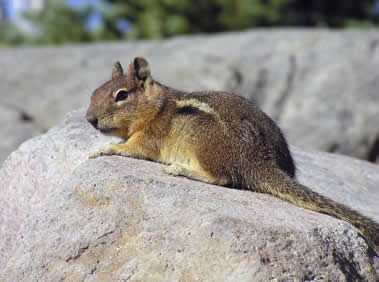
Cascade Mantled Ground Squirrel (Spermophilus saturatus ).
Photo by David Nagorsen.
Mammalian Species Diversity in BC
For a northern temperate region, British Columbia supports a surprisingly diverse mammalian fauna. The province is home to 137 native species of mammals (view the checklist for BC), another 13 species are exotics or aliens introduced to BC from other regions. Even if its 30 species of marine mammals (seals, sea lions, whales, sea otter) are excluded, BC still supports more mammals than any other jurisdiction Canada. This species richness reflects the complex physiography and habitat diversity of BC. It also is a legacy of historical biogeography with the modern mammals derived from several source areas including populations that persisted during the last glaciation in ice-free areas at the southern margins of the Cordilleran Ice Sheet, the Beringian refugium in northern Alaska and Yukon, and refugia associated with the Pacific coast.
Species richness of the land mammals is highest in southern parts of the province particularly the lower Fraser River basin and valleys of the dry interior and decreases with increasing latitude. A striking pattern reflecting the isolating effects of water barriers on mammals is the depauperate mammalian fauna on BC islands. Vancouver Island has only about half the land mammals found on the adjacent mainland and the isolated Haida Gwaii archipelago supports fewer than a third of the mammals that inhabit the nearby mainland.
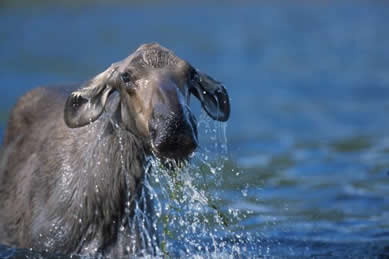
Moose (Alces alces). Photo by
Peter Llewellyn.
Taxonomic and Genetic Diversity
Results from recent molecular genetic studies based on DNA sequences have raised questions about the current taxonomy of BC mammals and the conventional definitions of taxonomic units such as species and subspecies. Studies based on mitochondrial DNA have revealed that mammals such as the American Marten, American Water Shrew, Yellow-pine Chipmunk, and Dusky Shrew have distinct genetic groups or lineages in BC separated by deep genetic splits that suggest species level differences. More genetic work with nuclear DNA is needed to confirm their taxonomic status. In contrast, the Vancouver Island Marmot, the only mammalian species endemic to the province, shows little DNA divergence from the mainland Hoary Marmot but is strongly differentiated from other marmots in its morphology and behaviour.
The subspecies category has been used to classify distinct geographic variants of a species. Although it has a long history in mammalian taxonomy, its use is controversial and some taxonomists consider the category to be of dubious value. Numerous subspecies have been described for BC mammals. Except for the hoofed mammals where the subspecies are well accepted and even have common names, mammalian subspecies are generally known only to the taxonomic specialist. Moreover, most were described 50-100 years ago from small samples using subjective descriptive traits. Patterns of genetic variation based on DNA are often inconsistent with currently recognized subspecies. The province has listed a number of mammalian subspecies as of conservation concern; however, the taxonomic validity of most of these needs to be confirmed with modern taxonomic studies.
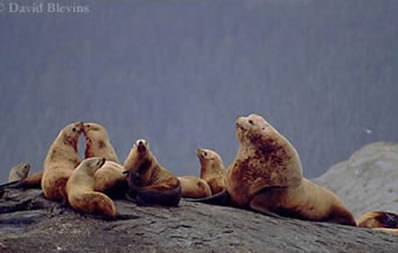
Steller Sea Lions (Eumetopias jubatus), photo by David Blevins
Mammal Studies in BC
With its populations of large charismatic carnivores and hoofed mammals and diverse life zones, BC has long attracted biologists and naturalists interested in the province’s land mammals. The first scientific studies on the distribution and taxonomy of the modern mammals were by naturalist-collectors and biologists associated with major museums in the United States and Canada. US institutions such as the American Museum of Natural History, the Museum of Vertebrate Zoology at the University of California, and the United States Biological Survey (now the United States National Museum) made important field collections of mammals in BC from the late 1880’s to the 1940’s. Canadian museums such as the National Museum of Canada (now the Canadian Museum of Nature), the British Columbia Provincial Museum (now the Royal British Columbia Museum), and the Cowan Vertebrate Museum at the University of British Columbia (now part of the Beaty Biodiversity Museum) also inventoried mammals and house extensive collections of the province’s mammals. The earliest work on the marine mammals was largely based on whale carcasses taken from commercial whaling and it was not until the 1970s that observational studies began. Over the past 30-40 years, biologists associated with various universities and federal and provincial government agencies have carried out extensive research studies on the province’s mammals. Management agencies such as Department of Fisheries and Oceans, Parks Canada, and BC Ministry of Environment have developed various management programs.
Numerous reports, monographs, scientific papers, and research notes have been published on the province’s mammals. Some are cited in the key references of the species accounts. The first general overview of the province’s mammalian fauna was the BC Provincial Museum’s handbook 11-The Mammals of British Columbia by Ian McTaggart Cowan and Charles Guiguet first published in 1956 and last revised in 1965. Dated and out-of-print, it has been updated in a series of mammal handbooks published by the Royal BC Museum.
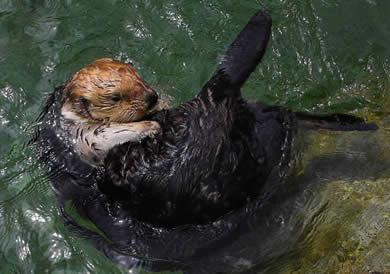
Sea Otter (Enhydra lutris). Photo by Brian Klinkenberg.
Conservation Issues
Thirty BC mammals (species, subspecies or populations) are listed nationally as endangered, threatened or special concern by COSEWIC (the Committee on the Status of Wildlife in Canada). The provincial red blue lists produced by the BC Conservation Data Centre, which provides status listings for BC species, includes 66 mammalian species, subspecies, or populations. For the land mammals most threats involve ongoing habitat loss or degradation from urban development, agricultural development, forest harvesting, mountain pine beetle infestations, resource extraction, flooding from hydroelectric dams, and roads. The introduction of alien or exotic mammals is another concern. Thirteen mammals have been introduced to BC but their impact on the native flora and fauna has not been well studied. The long term effects of global warming and climate change are difficult to predict but mammals such as the Hoary Marmot and American Pika may be particularly vulnerable to shifting tree-lines and habitat fragmentation.
Threats to marine mammals include collisions with ships, toxic chemicals including oil spills, acoustic disturbance, entanglement with fishing gear, and declining prey species. The large whales such as the Sperm Whale, Blue Whale, and Humpbacked Whale were hunted to near extinction during the commercial whaling era in the eastern Pacific. Although commercial whaling was banned in 1972 in Canada, Pacific populations of many of these great whales are still in the early recovery stage. Over fishing and warming sea temperatures associated with global warming could reduce fish stocks and the prey species of many marine mammals.
COSEWIC assessment reports and recovery strategies for BC mammals can be obtained from the federal Species at Risk Act (SARA) web site.

Townsend's Vole (Microtus townsendii). Photo by David Shackleton.
Selected References
MacDonald, S. O., and J. A. Cook. 2009. Recent mammals of Alaska. University of Alaska, Fairbanks. 387 pp.
Cowan, I. M., and C. J. Guiguet. 1965. The Mammals of British Columbia. Handbook No. 11. British Columbia Provincial Museum, Victoria, BC. 414 pp.
Dalquest, W. W. 1948. Mammals of Washington. University of Kansas Publications, Museum of Natural History 2:1-444.
Elbroch, M. 2003. Mammal tracks and sign. A guide to North American species. Stackpole Books, Mechanicsburg, Pennsylvania. 778 pp.
Feldhamer, G. A., B. C. Thompson, and J. A. Chapman, editors. 2003. Wild mammals of North America: biology, management, and conservation. 2nd ed. The John Hopkins University Press, Baltimore. 1216 pp.
Freemark, K., M. Meyers, D. White, L. Warman, A. Kiester, and P. Lumban-Tobing. 2006. Species richness and biodiversity conservation priorities in British Columbia, Canada. Canadian Journal of Zoology 84:20-31.
Hall, E. R. 1981. The Mammals of North America John Wiley and Sons, New York. 2 vols. 1181 pp.
Hatler, D. F., D. W. Nagorsen, and A. Beal. 2008. Carnivores of British Columbia. Royal British Columbia Museum, Victoria. 407 pp.
Johnson, R. E., and K. M. Cassidy. 1997. Terrestrial mammals of Washington State: Location data and predicted distributions. Vol. 3 in: K. M. Cassidy, C. E. Grue, M. R. Smith, K. M. Dvornich, (eds). Washington Sate Gap Analysis-Final Report. Washington Cooperative Fish and Wildlife Research Unit, University of Washington, Seattle. 304 pp.
Reid, F. 2007. A Field Guide to the Mammals of North America north of Mexico. 4th ed. The Peterson field guide series. Houghton Mifflin Co., New York. 579 pp.
Nagorsen, D. W. 1990. The Mammals of British Columbia: A Taxonomic Catalogue. Royal British Columbia Museum Memoir 4:1-140.
Nagorsen, D. W., and R. M. Brigham. 1993. Bats of British Columbia. University of British Columbia Press, Vancouver, BC. 164 pp.
Nagorsen, D. W. 1996. Opossums, Shrews and Moles of British Columbia. University of British Columbia Press, Vancouver, BC. 168 pp.
Nagorsen, D. W. 2005. Rodents and lagomorphs of British Columbia. Royal British Columbia Museum, Victoria. 410 pp.
Naughton, D. 2012. The Natural History of Canadian Mammals. University of Toronto Press, Toronto. 784 pp.
Nowak, R. M. 1999. Walker's Mammals of the World. 6th ed. 2 vols. The John Hopkins University Press, Baltimore. 1,550 pp.
Shackleton, D. M. 2013. Hoofed mammals of British Columbia. (Revised Edition), Volume 3 The Mammals of British Columbia, Royal BC Museum Publishing, Victoria, BC. 264 pp.
Smith, H. C. 1993. Alberta Mammals. An Atlas and Guide. The Provincial Museum of Alberta, Edmonton. 238 pp.
Soper, J. D. 1964. The Mammals of Alberta. The Hamley Press Limited, Edmonton. 402 pp.
Wilson, D. E., and S. Ruff. 1999. The Smithsonian book of North American Mammals. Smithsonian Institution Press, Washington, DC. 750 pp
Wilson, D. E., and D. M. Reeder, editors. 2005. Mammal Species of the World. A Taxonomic and Geographic Reference. 2 Vols. 3rd ed:. The John Hopkins University Press, Baltimore. 2,142 pp.
Youngman, P. M. 1975. Mammals of the Yukon Territory. National Museums of Canada, Ottawa, Ontario. Publications in Zoology 10: 1-192.
Useful Web Sites
American Society of Mammalogists.
Information on mammals including the technical publications Journal of Mammalogy and Mammalian Species which are detailed accounts for individual species. Archived issues of Mammalian Species can de downloaded for free.
Bat Conservation International.
An organization devoted to bat education, conservation, and research. Good source for information on bat houses, bat rabies and many other bat topics.
Smithsonian National Museum of Natural History. Searchable database for general species accounts of North American mammals with range maps and illustrations.
Wild Whales. BC Cetacean sighting network.
Partnership with the Vancouver Aquarium and DFO for tracking sightings. Useful information on whale conservation and identification.
Please cite these pages as:
Author, date, page title. In: Klinkenberg, Brian. (Editor) 2021. E-Fauna BC: Electronic Atlas of the Fauna of British Columbia [www.efauna.bc.ca]. Lab for Advanced Spatial Analysis, Department of Geography, University of British Columbia, Vancouver. [Date Accessed]
© Copyright 2021 E-Fauna BC.